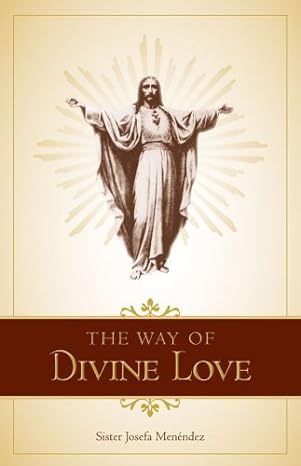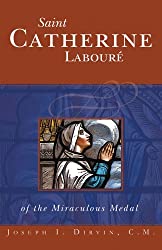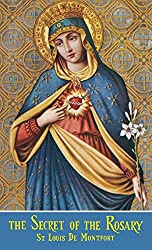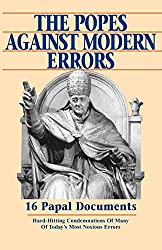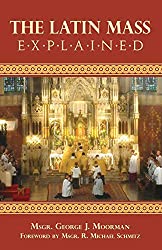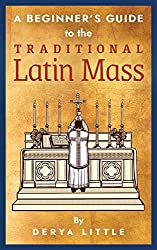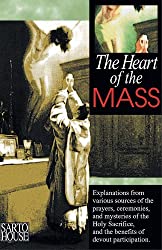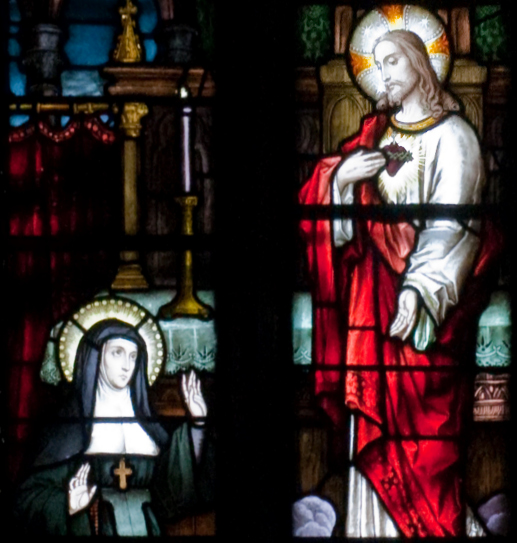
Introduction to St. Margaret Mary and the Sacred Heart
This account of the origins of the Cult of the Sacred Heart is taken from The Devotion to the Sacred Heart of Jesus, as written by one Father Hieronymus Noldin S. J. in 1883.
I have founding reading this instructive in numerous ways. It is meaningful not only for the account of the origins of the Devotion and the striking picture of the persecution that attended it (I could not help but be reminded of the atmosphere that surrounds the Latin Mass today!).
But also there is value, I think, to be had in the form of time-travel which can be afforded by such a piece – time travel in this case back into the very different soul of the Nineteenth Century, which breathes such a different kind of piety, intensity and spiritual commitment than can usually be found today.
Largely for reasons of clarity and easier assimilation from a computer screen, extremely minor editing and formatting changes have been introduced, including paragraph headings and breaks.
Finally, a number of those who have today been canonised Saints were not so when this was written and I have changed these e.g. Bl. Margaret Mary to St Margaret Mary.
And now over to the original text from 1883 – RB.

From Hieronymus Noldin S.J:

In the order of grace as in the order of nature, in the usual course of things no phenomena are seen, no events occur which have not been brought about by a gradual process.
In everything there is an organic connection and continuity, and from the tender germ, the small and feeble beginning, the plant is developed until it reaches perfection in the brilliant blossom or fully matured fruit.
In like manner the devotion to the Sacred Heart of Jesus did not appear all of a sudden in the Church, as a meteor in the nightly firmament; during the centuries preceding its introduction and propagation, its rise was long foreseen and the hearts of the faithful were prepared to welcome it.
It may be asserted with perfect justice that the devotion to the Sacred Heart of Jesus dates from the foundation of the Church. For its theological basis rests upon the principal and most well-known truths of our holy faith, and the sacred humanity of Our Lord was from the outset venerated and adored; hence it would be strange if Christian sentiment and love for Christ had never led the faithful in the first centuries to include the cultus of the Sacred Heart of the Redeemer in their practices of piety and devotion.
Before St Margaret Mary: Earlier Manifestations of the Devotion
And if in the earliest ages of Christianity little definite evidence is found to substantiate this fact, yet there are unmistakable elementary indications and traces of this devotion both in the writings of St. Paul and the writings of the Fathers afford abundant proof that for the Christians of the first centuries this was an object of homage and of love. and also in those of St. Augustine and St. John Chrysostom(1).
In the course of the Middle Ages we meet with a greater number of witnesses; as time goes on more and more devout and saintly souls come into view who know and practise this devotion, preeminently the two holy daughters of St. Benedict, St. Gertrude and St. Mechtilde, both of whom made the Heart of the Redeemer in a special manner the object of their fervent adoration.
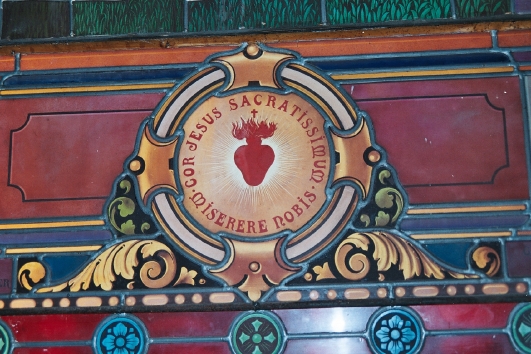
The work of the former, “The Messenger of Divine Love,” and that of the latter nun, “The Book of Spiritual Favors,” alike abound in prayers of intense fervor and touching exercises of piety to the Heart of Jesus, which were taught to them by the Holy Spirit.
In fact, so useful and so attractive did this devotion appear to St. Gertrude, so fully, so clearly did she know and appreciate the treasures laid up in that divine Heart, that in one of her numerous visions she asked St. John how it was that, since he had been privileged to lean upon Our Lord’s breast at the Last Supper, he had spoken so seldom and revealed so little concerning His Sacred Heart.
What Mechtilde and Gertrude effected in the Benedictine Order, that Landsberger did in the Carthusian Order. A century and a half before the revelations of St Margaret Mary, he both knew and practised the devotion to the Sacred Heart of Jesus himself, and spread it diligently. He it was who first drew attention to St. Gertrude’s writings, and by having them printed gave publicity to them.
Not only did he himself obtain an intimate knowledge of the Heart of his Lord, but he was also untiring in his efforts to acquaint others with the excellency, the beauty of that Heart, and, by the distribution of pictures of the Sacred Heart, to spread and popularize the cultus of it amongst all classes of Christians. By his direction every monk in the Carthusian monastery in Cologne set up a picture of the Heart of Jesus on the door or in the interior of his cell, and offered homage to it.
Others venerated in a similar manner the Sacred Heart of Our Lord, notably St. Bonaventure, St. Elzear, Ludol phus of Saxony, Henry Suso, B. Peter Canisius, St. Aloysius Gonzaga.
St John Eudes, St Francis de Sales and the Sacred Heart

The nearer one approaches to the seventeenth century, the more frequently are adorers of the Sacred Heart met with, the clearer and more definite is their knowledge of its virtues, the reverence wherewith they regard it.
But, as yet, their devotions are practised for themselves alone, forming part of their private prayers and meditations.
In the commencement of the seventeenth century, two figures stand out prominently who are remarkable for the surprising extent of their knowledge of the Heart of Jesus and the profound reverence they entertain for it.
The St John Eudes, the founder of the Eudist Fathers, in his writings and devotional exercises invariably spoke of the Heart of Jesus and that of Mary conjointly, giving perhaps greater prominence to the heart of Mary.
St. Francis of Sales was in this, as in other matters, the instrument chosen by Providence to execute the divine designs; he was to be the pioneer to prepare the way for the public recognition of this devotion.
He did not, it is true, attain to a full knowledge of it himself; he must, however, have had a vague, a dim presentiment that some development of a new and special nature was shortly to take place in the Church of God.
Foreword for Monarchy by Roger Buck
The Order of the Visitation – the Religious Community of St Margaret Mary
He gave the Order of the Visitation which he founded a heart encircled with a crown of thorns and surmounted by a cross as their armorial bearings and official seal; and he impressed on his spiritual daughters as their principal task to imitate the favorite virtues of the Sacred Heart, meekness and humility; above all to take the hidden life of Our Lord as their example.
Moreover, he thought the name of Daughters of the Holy Gospel or Daughters of the Heart of Jesus would be a suitable one for them to take; but neither of these was formally adopted.
This Order was founded expressly for the purpose of furthering the devotion to the Sacred Heart.
In it, as a grain of mustard-seed in a fertile soil, the germ of that devotion, destined to attain vast proportions and spread far and wide, was to be initially planted and carefully tended.
This design, however, never took actual shape in the saint’s mind, although his letters and his whole life show plainly how intimately he was acquainted with the secrets of Our Lord’s Heart, and how fervently he adored it; and in that school, the school of Christ, he acquired the perfection which raised him to the rank of a saint.
Consequently, when the time was come which the Most High in His eternal counsels had appointed for the introduction and propagation of this devotion, everything was prepared for it, prepared for it to expand in the full beauty of its bloom, like a rose from the unfolding bud.
Before all else it remained to be seen whom it would please God to make choice of to be in strumental in executing His designs, and again it was apparent that He prefers to employ the weakest, most insignificant individuals to bring to pass great things in His Church.
Just as in the thirteenth century, He chose a poor, obscure nun in a convent at Liege, named Juliana, to be the means of inaugurating the celebration of the festival of Corpus Christi, rather than the saintly Louis IX, king of France, or the erudite theologians St. Thomas Aquinas and St. Bonaventure, so for the institution and diffusion of the devotion to the Heart of Jesus He did not make use of the holy Doctor of the Church, St. Francis of Sales, but the poorest and humblest of his spiritual daughters in the Order of the Visitation, St Margaret Mary Alacoque.
Life and Visions of St Margaret Mary Alacoque
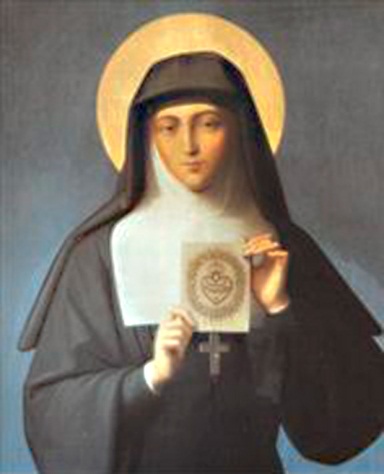
She was born in 1647 at Lauthecourt in France (2), and her youth was passed in innocence and piety. When about twenty-four years of age she embraced the religious life in the Order of the Visitation at Paray-le-Monial.
From her earliest childhood, God had taken this privileged and highly favored soul into His school, and constituted Himself her guide and teacher in the spiritual life. When she had been sufficiently trained in this school, and prepared for the task which was shortly to be entrusted to her, Our Lord commenced the series of revelations and instructions concerning His Sacred Heart, which must be regarded as the starting-point of the devotion.
St Margaret Mary had already been several years in the convent at Paray when the first revelation respecting the devotion to the Heart of Jesus was made to her.
She was engaged in prayer one day before the Blessed Sacrament, when Our Lord appeared to her, and opening His breast, permitted her to behold His Heart. It was surrounded with fire and flames, resplendent as the sun, transparent as crystal, encircled with a crown of thorns, and surmounted by a cross. Disclosing to her the marvels and mysteries of His love, He spoke thus to her:
My Heart is so full of love for men that it can no longer contain within itself the fire of charity. Through thy instrumentality it must flow out and make itself known to men, in order to enrich them with the treasures it contains. I will make thee acquainted with the priceless value of these treasures; they are salutary and sanctifying graces, and they alone are capable of rescuing mankind from the abyss of perdition. In spite of thy unworthiness and ignorance, I have chosen thee to carry out this My purpose, that it may be all the more evident that all is My work.
From that time forward the favors of which Margaret was the recipient became continually greater and more numerous. One day when she was praying before the Blessed Sacrament exposed, the Saviour appeared to her and made known to her the infinite magnitude of His love for men, bewailing their ingratitude and indicating this as the one among all His sufferings that He felt most acutely.
“If,” He said,
“they would only return love for love, all that I have done for them would be next to nothing; but I meet only with coldness on their part, and to My most loving invitations they respond only with contempt. Do thou at least give Me this solace: make amends to the utmost of thy power for their ingratitude.”
Overwhelmed with confusion and shame, she attempted to expostulate; but Our Lord reassured her and showed her in what manner and by what means He desired that in future she should venerate His Sacred Heart.
First of all, He bade her receive Holy Communion as often as she was permitted to do so; on the first Friday of each month she must certainly communicate; and finally in the night between Thursday and Friday, every week, she must rise between eleven o’ clock and midnight and, lying prostrate upon the floor, unite herself to Him in prayer in order to appease the anger of God and implore pardon for sinners.
Subsequently to these revelations and graces the humble handmaid of the Lord was favored with the Apparition of the 16th June, 1675, which afterwards attained such celebrity. It occurred on the Sunday in the octave of Corpus Christi, and it cannot be regarded otherwise than as the immediate cause of the public and general devotion to the Sacred Heart of Jesus.
On the day in question, while Margaret was praying before the Blessed Sacrament, animated by an intense longing to return love for love to Our Lord, He said to her: “Thou canst give Me no greater proof of thy love than by doing what I have already repeatedly asked of thee.”
Behold this Heart …
Then showing her His divine Heart, He went on:
Behold this Heart which has so loved men that it has spared nothing to testify its love for them, even to the exhausting and consuming of itself for their sake.
But in return for this I receive nothing from the generality of mankind but ingratitude through the contempt, irreverences, sacrileges, and coldness with which I am treated in this Sacrament of love. What, however, afflicts Me most is that even hearts which are consecrated to Me do Me this wrong.
Wherefore I require of thee that the first Friday in this octave [of Corpus Christi] should be appointed as a special festival in honor of My Heart, that satisfaction may be made to it on that day by a solemn act of reparation, and the faithful may receive holy communion to make amends for the outrages which are committed against it when it is exposed for veneration upon the altar.
I promise thee that My Heart shall so expand as to pour out the effect of its charity in superabundant plenitude on those who honor it, and who endeavor to prevail on others to pay it similar homage.
The timid nun was not a little startled and abashed at receiving this commission. “Alas! Lord,” she exclaimed, “whom hast Thou chosen for this purpose! The weakest of creatures, a poor sinner, whose unworthiness is in itself sufficient to frustrate Thy designs.”
“Knowest thou not,” the Lord answered her, “that I make use of the weak to confound the strong, that My power is displayed most signally in the little ones and the poor in spirit?”
“Then,” rejoined St Margaret Mary “provide me with the means of bringing to pass that which Thou desirest.”
Thereupon the Lord replied:
“Address thyself to My servant, Father de la Colombiere, whom I will send to thee, and tell him in My name that he must do his utmost to establish this devotion and thus rejoice My Heart. Let him not be discouraged by the difficulties which he will encounter; they will not be wanting, but he must remember that whosoever mistrusts himself and places all his trust in Me will prove omnipotent.”

St Claude La Colombiere
St Margaret Mary communicated all that had occurred to Father La Colombiere, who did not delay for a moment to do his Lord’s bidding. First of all he consecrated himself wholly and irrevocably to the Heart of the Redeemer (3).
Thenceforth both St Margaret Mary and St Claude La Colombiere did all that was in their power to make the Sacred Heart of Jesus widely known and universally honored; and the greater the obstacles they had to surmount, the more painful the humiliations which they had to bear whilst engaged in this work, the more signal were the results they achieved.
In the case of St Margaret Mary particularly, we see one whose life was wholly and exclusively devoted to the fulfilment of the task assigned to her, the introduction and diffusion of the devotion to the Heart of Jesus.
All her thoughts and affections were centred on this one object, the Heart of her Lord and Saviour; her aspirations, her prayers, all her works and her sufferings were directed to no other end than the propagation of the devotion to the Sacred Heart of Jesus; every word she uttered, every line she wrote had this for its single aim.
Great as was her natural aversion to speak or write on any subject, she overcame her disinclination whenever an occasion presented itself to extol and recommend to others her favorite devotion. (4)
Her state of life precluded her from any other external activity for the furtherance of the devotion, yet the unspeakable joy was afforded her, after, it is true, experiencing much opposition and bitter suffering, of seeing it enthusiastically taken up and zealously practised in the Order of which she was a member.
As for St Claude La Colombiere, it may be seen from his own memoranda how unremittingly and indefatigably this fervent servant of God devoted his life to the execution of the task entrusted to him by his divine Master Himself.
In his sermons, his spiritual conferences, his discourses, his letters, at all times and in all places he calls upon those whom he addresses to adore the Heart of Jesus and induce others to adore it also.

The Spread of the Sacred Heart Devotion after the death of St Margaret Mary
Yet if the devotion was to be more widely known and practised among all ranks of society, it was necessary that books and pamphlets explaining and advocating it should be disseminated amongst the working classes.
Our Lord had already revealed to St Margaret Mary that a work of this description should be composed by Fr. Croiset, and give a powerful impetus to the devotion.
The book in question appeared at last in the year 1691, and as St Margaret Mary was then dead (she died on l7th October, 1690) there was no objection to a biography of the departed nun and an account of the marvels which the Lord had wrought in her being added to it. This circumstance contributed vastly to interest the reader in the devotion and aid in its diffusion.
Yet, however zealously devout souls labored to spread the devotion, that which Our Lord had expressly enjoined on St Margaret Mary to bring about, the institution of a festival in honor of the divine Heart of Jesus, had not as yet been attempted, nor could it be accomplished with out the consent and permission of the Holy See. Application was accordingly made to the proper authorities.
Rome Responds Slowly to the Sacred Heart Devotion
But Rome moves slowly, and, true to its conservative principles, it hesitated long before the request was finally granted. The nuns of the Visitation and the ex-Queen Mary of England were the first to solicit in 1697 from Innocent XII. a special Office and Mass in honor of the Heart of Jesus; but their request was not acceded to.
In 1707, during the pontificate of Clement XI, the Order of the Visitation renewed their petition, yet again fruitlessly. About twenty years later, when Benedict XIII filled the Chair of Peter, fresh attempts from various quarters were made to obtain the long-wished-for favor, and great hopes of success were entertained, as the opinion of the Holy Father was known to be favorable.
The matter was submitted to the Congregation of Rites for examination. Fr. Galliffet, S.J., who was then residing in Rome, was appointed postulator causes, and Prosper Lambertini promoter fidei. For a long time the rea- sons pro and con were weighed and examined.
Meanwhile Fr. Galliffet was tireless in advocating the cause which he considered it to be his life’s task to further; and in his work entitled On the Devotion to the Sacred Heart of Jesus Christ, Our Lord and God he sought to give all the explanations and elucidations that were needed.
He did not live to see his dearest wish fulfilled. The Congregation were still adverse to granting the petition laid before them; there were still three difficulties as yet insufficiently solved which stood in the way of a favorable result of the negotiations.
The matter in question, it was said, was an innovation and at the best would lead to an unlimited increase in the ecclesiastical festivals; more over, the revelations of B. Margaret had not as yet undergone official examination and received formal approval; and finally, the granting of the petition was in a measure dependent on a philosophical question as yet undecided as to the seat of the sensible affections.
Not until renewed appeals were made in the reign of Clement XIII. and the subject again brought before the Congregation of Rites, a lengthy and exhaustive memorial having meanwhile been drawn up by the Polish bishops, in which all remaining difficulties and scruples were removed or explained away, was the petition urged so frequently and from such various quarters, finally granted.
Permission was given to celebrate the feast of the Sacred Heart, for which a special Office and Mass were appointed, but provisionally only in individual churches on application being made for this permission.
Thus official sanction was given to the devotion and it was raised to the rank of an ecclesiastical function. Numerous applications were made from all parts for the privilege of celebrating the newly instituted festival.
Anyone who followed all the negotiations carried on with the Holy See concerning this matter could not fail to be struck by two prominent facts.
In the first place, he could not but observe that the Church, far from being prepossessed in favor of this devotion and well-disposed towards it, rather regarded it with a cautious reserve, almost bordering on suspicion, when it was submitted to her for scrutiny; and in the second place, that during the investigations the revelations of St Margaret Mary were of no account, being almost entirely disregarded. 125
The main point with which the Church was concerned was to ascertain that the devotion rested on the immutable basis of Catholic dogma, and that it would tend to the greater glory of God as well as the salvation of man.
Consequently it is quite incorrect, to say the least, to assert that the devotion to the Sacred Heart of Jesus rests on the revelations made to a private individual, which very possibly may be illusory and deceptive.
It is true that it was owing to the revelations vouchsafed to St Margaret Mary that this devotion was practised by the faithful and examined by the Church, yet it was not in virtue of those revelations, but of the infallible dogmas of the faith, that ecclesiastical sanction was accorded to it.
One cannot, of course, suppose such a thing after they have undergone official scrutiny and been pronounced authentic, yet even were it possible for the revelations of B. Margaret to have been figments of the imagination, the devotion would lose nothing as to its interior truth or outward stability.
About the middle of the eighteenth century the devotion had already become widely known; in many localities, it was a popular and favorite devotion, for, since the Church had given her sanction to it, there was nothing to prevent it from spreading rapidly throughout the whole Catholic world.
Foreword for Monarchy by Roger Buck
Persecution of the Sacred Heart Devotion
Yet the following years were anything but favorable to its growth and diffusion. Proud and godless science, supported by the force of the law, rose up in angry antagonism to the Heart of Jesus and those who paid homage to it.
The Jansenists had from the outset displayed determined hostility to the cultus; and about the time of which we are speaking, posterior to the year 1765, their enmity knew no bounds.
The so-called enlightened principles of the day had penetrated even into the sanctuary and infected many a representative of the Catholic priesthood with their spirit, causing them to wither under its breath as the green leaves grow sere and yellow in the autumnal blast.
Thus it came to pass that unhappily some Catholic priests joined hands with the Jansenists in their hatred to the devotion and their rancor against those who practised it. The efforts made by that party in combination with the Austrian government to completely extirpate the “Jesuitical devotion,” as they were pleased to call it, are almost incredible.
The Jansenist bishop of Pistoja, Scipio Ricci, the Jansenistic periodicals Nou- velles ecclesiastiques in France and Annali ecclesiastici in Italy, the pseudo-synod of Pistoja, Bishop Morosini of Verona, one of the Illuminati, waged war against the devotion primarily by means of sophisms and misrepresentations, contempt and sarcasm, and where these weapons failed, the secular authority was appealed to for aid.

At first simple fines, later on imprisonment and banishment were the penalties inflicted; nay, the cultus of the Sacred Heart had even its martyrs. At the time of the French Revolution, the veneration of a picture of the Heart of Jesus was a crime punishable with death.
The proceedings of the enemies of this devotion were the same in all countries. At first in feuilletons and periodicals they poured out a perfect deluge of scorn and derision upon the devotion and its promoters.
True to their resolution to exterminate it from the world, they were not content with the means first employed, but applied to the government author ities, in order that the devotion might be forcibly suppressed, and its defenders silenced.
Nowhere was their application received so favorably as by the Austrian government. The devotion was interdicted from motives of state policy, and the propagation of it rendered punishable by law.
The astronomer royal, the well-known ex-Jesuit Maximilian Hell, was sentenced to pay the enormous fine of 500 florins, merely because he distributed some little books on the Sacred Heart; and one of the canons of the cathedral in Vienna was actually sent to prison for the same “crime.”
Priests who were desirous of taking their doctor’s degree in theology were compelled previously to promise that they would keep the Christian religion free from erroneous and pseudo-devotions.
Throughout the land, orders from high authority were issued to remove all pictures of the Sacred Heart of Jesus from the churches; and where this was not feasible, to cover them with a coat of whitewash.
In the Jesuit’s church at Innsbruck at the present day the picture which had then to be whitewashed is held in veneration, having been restored in the following year to its original condition at the request of the inhabitants of the Tyrol, and of the magistrate of the town.
The task of defending the devotion against the malicious attacks of these powerful enemies and propagating it amongst the faithful fell to the lot of the Society of Jesus.
The Jansenists and their adherents hoped all the more confidently to see it disappear from the face of the earth because the very Order on which it mainly depended for support had been forced to yield to stress of popular opinion, which was most adverse to it at that period.
Eventual Triumph of the Devotion to the Sacred Heart
But their hopes were not destined to be fulfilled. The members of the suppressed Order were stirred up to greater zeal and more unsparing efforts in the defence and furtherance of the much-abused devotion, because it was their firm belief that the toleration they enjoyed in Russia was to be attributed to the protection of the Sacred Heart of Jesus, and they earnestly besought and firmly hoped for the restoration of the Society throughout the whole of Christendom from the bounty of the divine Heart.
Consequently they exerted themselves to the utmost of their power to promote this cultus with word and pen; their efforts, however, met with isolated and scanty success. Not until more than half a century later, together with the revival of Catholic life and recognition of the Church’s claims, did brighter days dawn for this devotion.
During the glorious pontificate of Bl Pius IX of happy memory, it rose to the highest point of prosperity. In the year 1856, in accordance with the petition of the French bishops, the feast of the Sacred Heart was extended to the whole Church; and in1864 the beatification of the handmaid of the Sacred Heart of Jesus, M. Mary Alacoque, took place.
Besides the manifold blessings which Our Lord God bestowed everywhere with a lavish hand on the adorers of the Heart of Jesus, nothing contributed so much to further and give importance to this cultus as the fact that the favored disciple of the divine Heart was raised by the Church to our altars.
Finally Bl. Pius IX crowned all his exertions for the propagation of the devotion by dedicating the whole Church to the divine Heart of Our Lord.
When in 1865 the bicentenary of the devotion to the Sacred Heart of Jesus was celebrated, the Holy Father gave permission to every member of his flock throughout the whole Catholic world to consecrate him or her self individually in like manner, by the use of an act of consecration, the formula of which was approved by the Congregation of Rites.
Thus at the present time all that the most zealous and ardent adorers of the Heart of Jesus longed and looked for has been accomplished. 135 The devotion has received the highest ecclesiastical sanction, and everything possible on the part of the Holy See has been done to promote it and commend it to the faithful. It may be said with truth that there is scarcely a single diocese and but few parishes which have not been dedicated publicly and solemnly to the Heart of Jesus, and in which the devotion is not fervently practised; in fact, having now spread throughout the whole Church, it has become a popular and favorite devotion.
Into whatever church one enters one is almost sure to see an altar of the Sacred Heart, or at least an image of it, with unmistakable evidence of the homage paid to it by Christian people; and wherever instruction in the catechism is given to children by a priest, or even by a neophyte in some remote heathen land, he shows them a picture of the Sacred Heart, tells them of the unbounded charity of the Saviour, and teaches them to venerate His Sacred Heart and return love for love.
No less than one-and-thirty Messengers of the Divine Heart of Jesus 1 proclaim in as many different languages the unfathomable riches of this Heart, and publish to all the world the countless blessings and graces wherewith the pious devotion and trust of the faithful are munificently rewarded.
Nor is this to be wondered at, for whoever acquaints himself with the history of the devotion and considers its present wide diffusion, the happy fruits and benedictions that attend it, with an unbiassed mind cannot fail to acknowledge: This is the work of God.
It bears unmistakably the impress of the threefold mark which always and everywhere distinguishes the work of God: the instrument chosen by God was in itself weak and apparently most unfit for the accomplish ment of the object in view; the devotion, small and insignificant in its beginnings, has, like the grain of mustard-seed, attained gigantic proportions and spread over the whole world, dispensing blessings on every hand; and after a prolonged and fierce contest, in which it often appeared to succumb, a brilliant and glorious victory followed, all the assaults of an adversary far superior in numbers and strength having only served to accelerate its growth and diffusion.
In the light of these facts all prepossessions against the devotion must vanish like mist before the rising sun. For some persons it is too lofty and sublime, too mystic and ideal; for others, on the contrary, too sensuous and carnal; while others pronounce it to be fantastic and sentimental.
Foreword for Monarchy by Roger Buck
In as far as these judgments do not refer to reprehensible exaggerations or perversions, the answer may be made: “O man, who art thou that repliest against God?” (1 Rom. ix. 20)
Once this much is certain, that we have to do with what is God s work, all objections must fall to the ground ; criticism is presumption, censure is rebellion against the Spirit of the Lord.
Original Footnotes to this text can be found below.
Of Related Interest at this Site:
Book Review: The Life of St Margaret Mary Alacoque by Emile Bougaud
Book Review: The Autobiography of St Margaret Mary
Original Footnotes:
1. It is true that this devotion in its initial stage was directed rather to the wound in the Saviour s side, and consequently to His pierced Heart, than to the Heart as an emblem of His love. See the treatise: Theses de cultu sacratissiti Cordis Jesus a P.P. A Martorellet J. Castella,S.J.
2. The dates in the life of B. Margaret Mary given in this and in the following chapter are taken from her autobiography and from the Life of the Ven. Sister M. M. Alacoque, by the Rev. M. Strom, Cologne and Neuss, 1875. For the facts relating to the history of the devotion and of the feast the author is indebted to Father Hattler’s ” History of the Feast and the Devotion of the Heart of Jesus,” and to the well-known work: De ratio nib us festorum 5.5. Cordis Jesu e,t pur. Cordis Maria, by N. Nillesand.
3. This act of consecration and the occasion of it are given in St. Claude La Colombiere’s “Spiritual Diary.” This Diary is in general a real treasure for the Christian who seriously strives after virtue and perfection. From it we learn the secrets of a soul who was not from the outset the recipient of graces lavishly outpoured, nor did he find himself almost without a conflict against his corrupt nature admitted to the full possession of divine love ; on the contrary we see one who, after a fierce struggle and hard-fought battle with his inherent frailties and evil tendencies, by long years of unremitting vigilance finally climbed to the height of sanctity on which we behold and admire him.
4. The writings which we have from the pen of St Margaret Mary, composed principally during the later portion of her life, are: i. An autobiography, written in obedience to the order of her confessor (Fr. Ignatius Rolin, S.J.); 2. A considerable number of letters, all of them written for the purpose of promoting the devotion to the Heart of Jesus; 3. A series of counsels, hints, and instructions concerning the spiritual life, given, some orally, some in writing, while she was mistress of novices; 4. A collection of prayers and aspirations to the Sacred Heart of Jesus, composed for her own use and to be given to others. All these writings were arranged and published in two volumes on the occasion of her beatification by the Convent of the Visitation in Paray, entitled Vie et Oeuvres de la B. Marg. Marie Alacoque.
Foreword for Monarchy by Roger Buck
Buying Books at Amazon Through These Links Gives Us a Commission. This Supports Our Apostolate. Thank You if You Can Help Us Like This!





